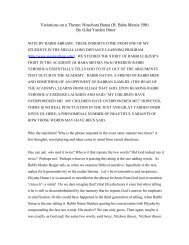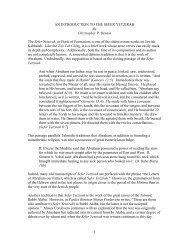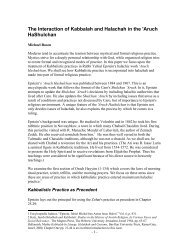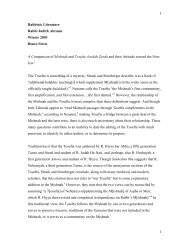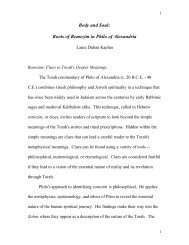The Symbolic Representation of the Sefer Torah - Maqom
The Symbolic Representation of the Sefer Torah - Maqom
The Symbolic Representation of the Sefer Torah - Maqom
Create successful ePaper yourself
Turn your PDF publications into a flip-book with our unique Google optimized e-Paper software.
writes: “It is directed toward a particular goal and becomes, among o<strong>the</strong>r things, a mechanism forachieving those goals. Religious ritual connects <strong>the</strong> participant to some transcendent presence. It providesa bridge to G-d by engaging <strong>the</strong> participant in an act that G-d has commanded. At <strong>the</strong> very least, it isefficacious in <strong>the</strong> sense that it is pleasing to G-d or avoids G-d's displeasure. But it only produces <strong>the</strong>desire results when preformed correctly.” Ritual is generally resistant to change and detailed in its content.Examples <strong>of</strong> ritual are some <strong>of</strong> <strong>the</strong> mitzvoth (sing. mitzvah: commandment) described in detail in Jewishlaw or halakha.In contrast to ritual, Liebman explains that ceremony is connected directly to <strong>the</strong> social order itrepresents. For example, in reform synagogues <strong>the</strong> traditions observed such as <strong>the</strong> removing <strong>the</strong> <strong>Torah</strong> arenot based upon law or mitzvoth but are chosen because <strong>of</strong> <strong>the</strong>ir importance in <strong>the</strong> eyes <strong>of</strong> <strong>the</strong> congregants.Liebman describes <strong>the</strong> ceremony (1999, p. 309). “<strong>The</strong> Sabbath service in a Reform synagogue may notinclude reading from <strong>the</strong> <strong>Torah</strong> or may include reading only a few lines ra<strong>the</strong>r than <strong>the</strong> entire weeklyportion, but it will include a ra<strong>the</strong>r elaborate ceremony in which <strong>the</strong> <strong>Torah</strong> scrolls are taken out <strong>of</strong> andreturned to <strong>the</strong> highly ornamented ark in which <strong>the</strong>y are kept. A bar mitzvah ceremony in a Reformsynagogue might have <strong>the</strong> rabbi removing <strong>the</strong> <strong>Torah</strong> scroll from <strong>the</strong> ark and handing it to <strong>the</strong> parents or <strong>the</strong>youngster whose bar mitzvah is being celebrated. <strong>The</strong> parents, in turn, hand <strong>the</strong> <strong>Torah</strong>, in this case asymbol <strong>of</strong> Jewish tradition, to <strong>the</strong> bar mitzvah celebrant.” In this case, <strong>the</strong> actors do not believe <strong>the</strong>iractions to be a mitzvah requiring precise and detailed rules determined by generations <strong>of</strong> rabbinicalauthorities. <strong>The</strong>ir performance is a symbolic act whose social nature in this case is quite explicit. AsLiebman continues to explain, “<strong>The</strong> ceremony symbolizes <strong>the</strong> ties between parent and child in a Jewishcontext; <strong>the</strong> centrality <strong>of</strong> generational continuity and <strong>the</strong> special role <strong>of</strong> <strong>the</strong> parent-child relationship intransmitting <strong>the</strong> <strong>Torah</strong> (i.e. tradition). <strong>The</strong> ceremony clearly manifests and affirms <strong>the</strong> participation andidentification <strong>of</strong> <strong>the</strong>se actors in <strong>the</strong> Jewish social order. In <strong>the</strong> words <strong>of</strong> Malina (1986, p. 7), a cultureprojects “collective communication.”While I agree with Liebman’s definition <strong>of</strong> ritual and ceremony, <strong>the</strong>re is also a grey area that hediscusses: customs that vary in different communities and Jewish ethnic groups. In our discussion about16



